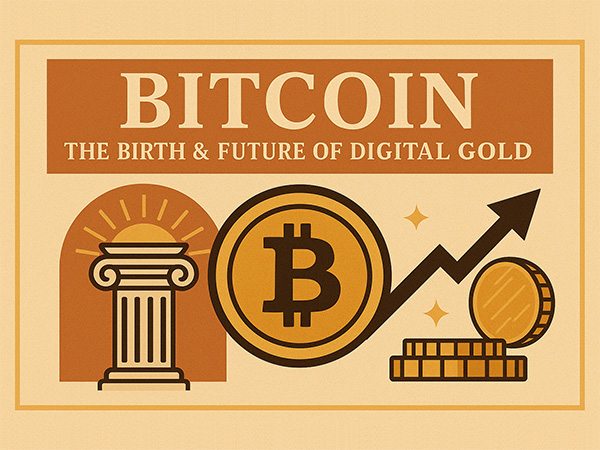Bitcoin: The Birth and Future of Digital Gold

In the wake of the 2008 financial crisis, a white paper titled "Bitcoin: A Peer-to-Peer Electronic Cash System", authored by the mysterious Satoshi Nakamoto, quietly emerged. This revolutionary document introduced Bitcoin (BTC), an electronic currency designed to be resistant to inflation and independent of banking intermediaries. By leveraging cryptography and distributed ledger technology, Bitcoin achieved true digital scarcity for the first time in human history.
1. The Essence of Bitcoin and the Mystery of Its Creator
At its core, Bitcoin is a decentralized network for storing value. Unlike traditional currencies, it is not issued by a central bank and has a fixed total supply of 21 million coins. Its issuance rate is halved every four years, giving it a deflationary nature. The real identity of Satoshi Nakamoto remains unknown to this day. After 2010, Nakamoto disappeared from the internet, leaving behind approximately one million early Bitcoins. This intentional absence of a central authority strengthens Bitcoin’s “code is law” resistance to censorship.
2. How Bitcoin Works: A Brilliant Application of Blockchain Technology
When you send Bitcoin to a friend, three intricate processes occur behind the scenes:
-
Transaction Broadcast: Your transaction request is sent to tens of thousands of nodes around the world.
-
Miner Verification: Miners compete using computational power to package the transaction into a block (one block is generated approximately every 10 minutes).
-
On-Chain Confirmation: The new block is added to the blockchain in chronological order. After six confirmations, the transaction becomes irreversible.
This process relies on the Proof-of-Work (PoW) mechanism—miners consume electricity to solve mathematical problems and earn block rewards (3.125 BTC as of 2025). This design makes it extremely costly to tamper with historical transactions. An attacker would need to control 51% of the entire network’s computing power and rewrite all blocks, incurring electricity costs far greater than any potential reward.
3. Bitcoin Blockchain: A Revolutionary Distributed Ledger Architecture
The Bitcoin blockchain is essentially a globally synchronized public ledger, built upon three groundbreaking innovations:
-
Timestamp Chain: Each block contains the cryptographic fingerprint (hash) of the previous block, forming an unbreakable chain.
-
Merkle Tree: Thousands of transactions are compressed into a single digital fingerprint, enabling efficient verification.
-
UTXO Model: The “Unspent Transaction Output” (UTXO) system tracks account balances and prevents double-spending.
This architecture has kept the Bitcoin network secure and unbreached for 17 years, making it the most robust financial infrastructure in human history.
4. Multiple Ways to Buy Bitcoin (Latest 2025 Practices)
Fiat-to-crypto purchase remains the mainstream method:
-
PayPal/Revolut: Users in Europe and the U.S. can directly buy BTC, but cannot withdraw to private wallets.
-
Bitcoin ATMs: Over 150,000 machines worldwide support cash purchases, with fees ranging from 7% to 15%.
-
P2P Platforms: On platforms like LocalBitcoins, buyers can select sellers and complete transactions via Alipay or bank transfer—checking seller ratings is essential.
Key Risk Control Steps:
-
Create a cold wallet (e.g., Ledger) as the receiving address first.
-
Conduct a small test transaction (≤ $50) to confirm security.
-
Split large purchases into multiple wallet addresses.
5. The Future of Bitcoin: Tech Upgrades and Regulatory Challenges
The Bitcoin ecosystem in 2025 shows two major trends:
-
Technological Iteration: The Lightning Network can now process up to 1 million transactions per second, enabling micropayments like buying coffee.
-
Regulatory Divergence: After the U.S. SEC approved spot ETFs, institutional capital surged in. Meanwhile, China and India still prohibit fiat conversion channels.
In the long term, Bitcoin faces the threat of quantum computing—Shor’s algorithm could potentially break elliptic curve encryption. However, post-quantum signature schemes like Lamport are already being deployed on testnets. On the environmental front, 65% of global Bitcoin mining now uses clean energy, with new mining hubs emerging around Norwegian hydropower and Texan wind farms.
6. The Double-Edged Sword of Bitcoin Investment: Risk vs. Reward
Potential Rewards:
-
Historical annualized return >150% (2010–2025), a powerful hedge against fiat depreciation.
-
Post-2025 halving increases scarcity, with institutions holding 23% of circulating supply.
Major Risks:
| Risk Type | Typical Case | Defensive Strategy |
|---|---|---|
| Volatility Risk | 2022 LUNA crash caused BTC to halve | Use DCA (Dollar-Cost Averaging) |
| Policy Risk | 2024 Russia froze exchange assets | Spread assets across 5 compliant platforms |
| Operational Risk | 2023 FTX collapse wiped out user funds | Store >90% in cold wallets |
7. Bitcoin Storage Security: From Beginners to Whales
Layered Storage Strategy:
-
Hot Wallet (<5%): Exchange wallets or Trust Wallet for daily use. Enable 2FA and phishing protection codes.
-
Cold Wallet (Core Assets): Hardware wallets like Ledger/Trezor. Store mnemonic phrases on titanium plates kept in a bank safety deposit box.
-
Multisignature Wallet (> $1M): Requires 2 out of 3 private keys to authorize transactions, mitigating single-point failures.
2025 Hard Lessons:
-
One whale lost 12,000 BTC after storing mnemonic phrases in iCloud, which was hacked.
-
Incidents of hardware wallets being destroyed by microwaving for “dehumidifying” increased 37% year-over-year.
Conclusion: Safeguarding Financial Sovereignty in a Tech Revolution
Bitcoin is not merely a financial instrument—it represents a redefinition of monetary freedom. Its underlying blockchain is reshaping trust mechanisms. From legal tender in El Salvador to donation rails during the Ukraine war, Bitcoin has proven its vitality as a supranational value network.
For individual investors, success hinges on: understanding the technology, following cold storage best practices, and resisting the temptation of leverage. As Satoshi Nakamoto embedded in the Genesis Block—“The Times 03/Jan/2009 Chancellor on brink of second bailout for banks”—Bitcoin was born from the vision of returning financial control from institutions to individuals.
The moment you hold your private keys in a cold wallet, you’ve joined one of the greatest experiments in financial self-sovereignty in human history.
-
Sign Up

OKX
OKX is a leading global digital asset trading platform offering spot and derivatives services for cryptocurrencies.
-
Sign Up

Binance
Binance is one of the world's largest cryptocurrency exchanges, offering spot, futures, staking, and a wide range of digital asset services.
-
Sign Up

Bybit
Bybit is a global cryptocurrency exchange specializing in derivatives, spot trading, and crypto-financial products.
-
Sign Up

Gate.io
Gate.io is a leading crypto exchange offering diverse trading options, low fees, and strong security since 2013.
